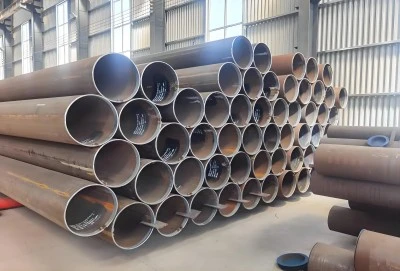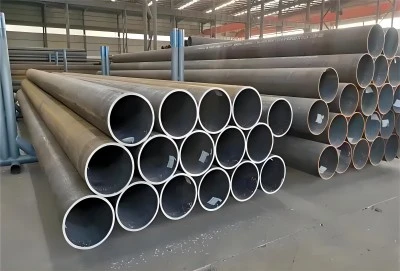In the oil and gas industry, the integrity of pipeline infrastructure is paramount. One of the most significant challenges faced by engineers and operators is the corrosion of pipelines, particularly in highly acidic environments. This study delves into the corrosion resistance of X65 pipe, a widely used material in the industry, when exposed to highly acidic media. We'll explore evaluation methods, enhancement techniques, and compare various corrosion protection approaches to ensure the longevity and safety of X65 pipelines.
|
|
|
Evaluating the Effectiveness of X65 Steel in Acidic Environments
X65 steel, known for its high strength and durability, is a popular choice for oil and gas pipelines. However, its performance in highly acidic conditions requires careful scrutiny. To evaluate the effectiveness of X65 steel in these challenging environments, researchers employ a variety of sophisticated techniques:
1.Electrochemical Impedance Spectroscopy (EIS)
EIS is a non-destructive method used to analyze the corrosion behavior of X65 steel in acidic media. This technique provides valuable insights into the corrosion mechanisms and the formation of protective layers on the steel surface. By applying a small amplitude sinusoidal potential excitation and measuring the current response, researchers can determine the impedance of the system, which correlates with the corrosion resistance of the material.
2.Weight Loss Measurements
A straightforward yet effective method to assess corrosion resistance is through weight loss measurements. X65 steel samples are exposed to acidic solutions for predetermined periods, after which the weight loss is measured. This approach provides quantitative data on the corrosion rate and helps in comparing the performance of different corrosion protection strategies.
3.Surface Analysis Techniques
Advanced surface analysis methods such as X-ray Photoelectron Spectroscopy (XPS) and Scanning Electron Microscopy (SEM) are employed to examine the morphology and composition of corroded X65 steel surfaces. These techniques offer valuable insights into the nature of corrosion products and the effectiveness of protective coatings or inhibitors.
4.Polarization Curves
Potentiodynamic polarization measurements provide information on the corrosion potential and current density of X65 steel in acidic media. By analyzing these curves, researchers can determine the corrosion rate and the effectiveness of various corrosion mitigation strategies.
Through these evaluation methods, scientists and engineers can gain a comprehensive understanding of how X65 steel performs in highly acidic environments. This knowledge is crucial for developing effective corrosion protection strategies and ensuring the long-term integrity of pipelines.
5.Enhancing Corrosion Resistance of X65 Pipelines for Aggressive Chemical Exposure
While X65 steel offers excellent mechanical properties, its corrosion resistance in highly acidic media can be further improved through various enhancement techniques. These methods aim to create a more resilient surface or alter the chemical environment to mitigate corrosion:
6.Surface Modification Techniques
Modifying the surface of X65 steel can significantly enhance its corrosion resistance. Some effective techniques include:
- Nitriding: This process involves diffusing nitrogen into the steel surface, creating a hard, corrosion-resistant layer.
- Carburizing: Similar to nitriding, this technique introduces carbon into the steel surface, improving both hardness and corrosion resistance.
- Shot Peening: By bombarding the surface with small metallic shots, this method induces compressive residual stresses, which can improve corrosion resistance.
7.Advanced Coating Technologies
Applying protective coatings is a widely used method to enhance the corrosion resistance of X65 pipe. Some cutting-edge coating technologies include:
- Nanocomposite Coatings: These coatings incorporate nanoparticles to create a dense, impermeable barrier against corrosive media.
- Graphene-based Coatings: Utilizing the exceptional properties of graphene, these coatings offer superior corrosion protection.
- Sol-gel Coatings: These inorganic-organic hybrid coatings provide excellent adhesion and corrosion resistance.
8.Corrosion Inhibitors
Chemical inhibitors can be added to the acidic media to reduce its corrosiveness. Some effective inhibitors for X65 steel include:
- Organic Inhibitors: Compounds such as imidazoline derivatives and quaternary ammonium salts can form protective films on the steel surface.
- Inorganic Inhibitors: Substances like sodium molybdate or sodium nitrite can passivate the steel surface, reducing corrosion rates.
- Vapor Phase Inhibitors: These volatile compounds can protect areas that are difficult to reach with liquid inhibitors.
9.Cathodic Protection
Cathodic protection is an electrochemical technique that can significantly reduce corrosion rates in X65 pipelines. This method involves:
- Impressed Current Cathodic Protection (ICCP): An external power source is used to supply electrons to the pipeline, preventing corrosion.
- Sacrificial Anodes: Less noble metals are connected to the pipeline, preferentially corroding and protecting the X65 steel.
By combining these enhancement techniques, the corrosion resistance of X65 pipelines can be significantly improved, even in highly acidic environments. The choice of method depends on factors such as the specific acidic media, operational conditions, and cost considerations.
Comparative Study of Corrosion Protection Techniques for X65 Pipelines in Acidic Conditions
To determine the most effective corrosion protection strategy for X65 pipe in highly acidic media, it's essential to conduct comparative studies of various techniques. This section presents a comprehensive analysis of different protection methods, evaluating their effectiveness, durability, and cost-efficiency.
1.Methodology
The comparative study involves exposing X65 steel samples treated with different protection techniques to simulated acidic environments. The following parameters are typically assessed:
- Corrosion Rate: Measured through weight loss and electrochemical methods.
- Surface Morphology: Analyzed using SEM and Atomic Force Microscopy (AFM).
- Chemical Composition: Evaluated using XPS and Energy Dispersive X-ray Spectroscopy (EDS).
- Long-term Performance: Assessed through accelerated aging tests.
- Cost-effectiveness: Considering both initial implementation and maintenance costs.
2.Results and Discussion
The comparative analysis reveals the following insights:
(1). Coating Performance
Among the coating technologies, nanocomposite coatings showed superior performance in highly acidic media. The incorporation of nanoparticles significantly enhanced the barrier properties, resulting in lower corrosion rates compared to traditional epoxy coatings. Graphene-based coatings also demonstrated excellent corrosion resistance but faced challenges in large-scale application due to high production costs.
(2). Surface Modification Techniques
Nitriding proved to be highly effective in improving the corrosion resistance of X65 steel. The formation of a dense nitride layer significantly reduced the corrosion rate in acidic environments. However, the high-temperature process required for nitriding can affect the mechanical properties of the steel, necessitating careful control of process parameters.
(3). Corrosion Inhibitors
Organic inhibitors, particularly imidazoline derivatives, showed promising results in reducing corrosion rates. These inhibitors formed a stable protective film on the X65 steel surface, effectively mitigating corrosion in acidic media. However, their effectiveness decreased over time, requiring periodic reapplication.
(4). Cathodic Protection
Impressed Current Cathodic Protection (ICCP) demonstrated excellent long-term corrosion protection for X65 pipelines. While the initial installation costs were higher compared to other methods, ICCP provided consistent protection and was particularly effective for large pipeline networks.
3.Cost-Benefit Analysis
When considering the long-term protection of X65 pipe in highly acidic environments, a combination of techniques often proves most effective. For instance:
- Applying a nanocomposite coating as a primary barrier
- Implementing ICCP for continuous protection
- Using organic inhibitors as a supplementary measure
This multi-layered approach provides robust protection while optimizing cost-efficiency over the pipeline's lifespan.
Contact Information
The study on corrosion resistance of X65 pipe in highly acidic media reveals that while X65 steel offers good mechanical properties, its corrosion resistance can be significantly enhanced through various protection techniques. The choice of method depends on factors such as the specific acidic environment, operational conditions, and economic considerations.
Nanocomposite coatings and ICCP emerge as particularly effective strategies for long-term protection. However, a combination of methods often provides the most comprehensive and cost-effective solution for protecting X65 pipelines in challenging acidic environments.
Continued research and development in this field are crucial for improving the durability and safety of oil and gas infrastructure. As new materials and technologies emerge, the corrosion resistance of X65 pipelines in highly acidic media will undoubtedly continue to improve, ensuring the integrity of critical energy infrastructure for years to come.
For more information on X65 pipe and our range of corrosion protection solutions, please contact us at info@longma-group.com. Our team of experts is ready to assist you in selecting the most suitable protection strategy for your specific needs.














